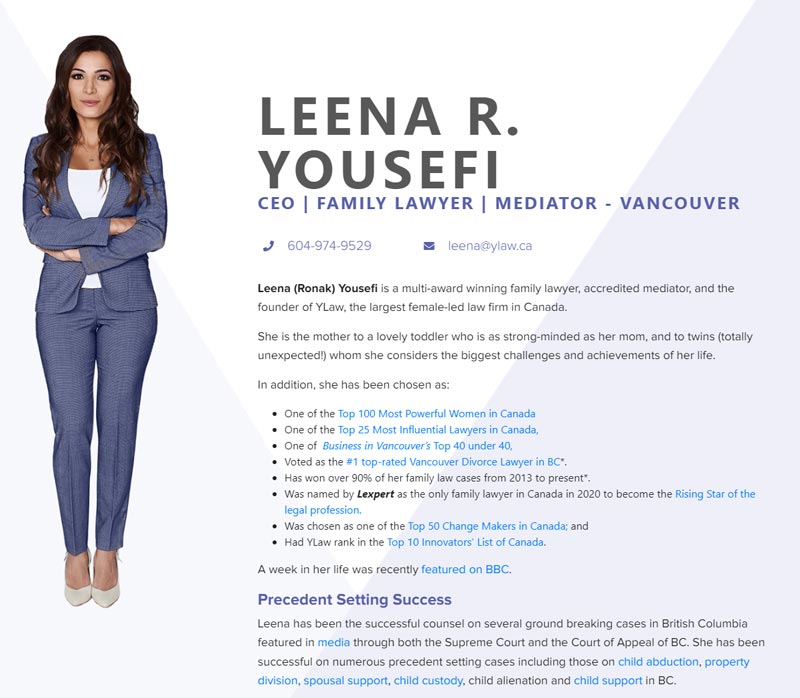If there’s one constant refrain legal marketers hear all the time, it’s that attorney bio pages are one of their firm website’s most critical sections.
‘Experts’ harp on the importance of bio pages, often citing visitation statistics to these areas as evidence of their importance. In our own experience, we haven’t necessarily found visitation figures to be this high; we find them to be highly variable. But there’s no denying that, in most cases, visitation rates to bio pages are high, relative to other areas of a firm’s website.
All this makes sense. Lawyers – like accountants, architects, and financial planners – are professional service providers. Unlike companies who make things – and design their branding around the features and benefits of the things they make – in a law firm the lawyer is the brand. Which makes the art and science of writing and designing a bio page a branding exercise, in and of itself.
So then, let’s get on with it. What, exactly, are some of the things legal marketers should be thinking about in both the writing and design of the ‘perfect’ attorney bio page?
Here’s our take on the matter.

Part One: Writing the Ideal Attorney Bio Page
1) Start with the Basics
Although an aim of this post is to highlight often-overlooked details in an attorney bio page, we’d be remiss to mention some basics that many attorneys still fail to provide.
Besides the name and title of the attorney, practice area affiliations and contact information are fundamentals which must be front and center.
And a note about your contact information: rather than offering a direct email link, consider having a ‘contact me’ button which launches a form. This form can collect useful information from the person reaching out to you and will also protect your email address from being harvested and spammed.
2) Introduce your Attorney’s Personal Brand
Writing an Attorney Bio Page is first and foremost a branding exercise. The objectives are two-fold. Although the page is a story about the individual lawyer, it also supports a larger narrative about the collective brand identity of the firm itself. It’s true that an individual law firm’s identity is determined by a mix of factors – practice areas, size and execution differences – but the reputation of individual practitioners within the firm greatly impacts reputation and brand identity.
Approaching each bio as a distinct branding exercise, then, involves both communicating the lawyer’s unique professional and temperamental qualities and explaining how those enhance the larger identity of the firm itself. Each bio should be thought of as an opportunity to tell an individual story. Too often, law firm bios lead with writing that begins something like this:
John Doe is a partner with XYZ Law Firm and handles corporate restructuring, workouts, and general bankruptcy litigation.
Introductions like this one are impersonal and say nothing that makes the reader want to pick up the phone or reach out with an email. Rather than leading with a dry recitation of practice area focus, try crafting a more personal narrative which blends both personal and professional interests. One of our favorite websites, over the last five years or so, has been a site for the Singaporean firm, TSMP Law Corporation. They’ve changed their bio writing recently, but a former narrative for one of their partners really struck us:
“Jonathan is not a very good lawyer – before he has his morning coffee. It’s a good thing he never forgets it. Over the years, his clients have been impressed with his timely and high-quality work, leading to his work being mentioned in various legal journals such as Legal 500 Asia Pacific (2013 and 2014 Editions), IFLR 1000 (2013 Edition) and Asialaw Profiles (2013 and 2014 Editions).”
One aspect of this narrative that we really like is that it builds trust. Who can really trust someone that doesn’t need caffeine in the morning?
Another great example of a bio comes from the Family Law firm, YLAW in Canada. Describing its founder, the first two paragraphs of her bio read:
“Leena (Ronak) Yousefi is a multi-award winning family lawyer, accredited mediator, and the founder of YLaw, the largest female-led law firm in Canada.
She is the mother to a lovely toddler who is as strong-minded as her mom, and to twins (totally unexpected!) whom she considers the biggest challenges and achievements of her life.”
Leena’s bio leads with an unbeatable one-two punch for a family lawyer. It communicates that she wins. And that she’s a mom, who considers her children her greatest achievements.
Who doesn’t want to hire a family lawyer like that?
Splat Has Been Growing Legal Brands on the Web Since 2003, Using the Latest in Web Design, Development, and Inbound Marketing.
3) Think like a Copywriter: the Features and Benefits Argument
There’s an old adage that copywriters rely on which speaks to the craft of selling both products and professional services. Talk about the features, but sell the benefits.
What does this mean? Let’s pretend we’re selling something like a BMW 7 Series sedan. Two features of the electric version of this car are its 536 horsepower engine and its zero to 60 speed, which is a swift 4.5 seconds. But the really powerful prose on the page conjures the benefits that most luxury automobile buyers crave…
Where you belong.Wherever your life may lead, you’ll arrive in style with the new BMW 7 Series Sedan. Unmatchable luxury lets you connect with what matters – or disconnect and enjoy the ride.
And how might benefits express themselves in a legal bio? Suppose I’m a tax attorney. I could talk about experience, credentials, and professional experience. But what is more likely to move prospects to act is languages such as, “as part of her regular services to an long-time client, Marjorie saved one of her small-business clients 2.3 million dollars in federal and state taxes, in 2022 alone.”
4) Mention Relevant Experience
Developing a benefits-based argument in the earlier part of your biography allows you to seamlessly segue into a section allowing you to detail relevant experience. Think of this as both an opportunity to elaborate on the benefits you’ve provided to your clients and an opportunity to further prove value. “Proof” is a concept that marketers talk ceaselessly about. Your clients want to feel reassured that, if they choose you, you’ll be able to perform. (Pro tip: Consider building your website in such a way as to cross-reference article content, based on individual attorney authorship. In other words, if one of your attorneys has recently written a piece on intellectual property law, ensure those pieces are linked to in his/her biography.) All this talk about proof and experience leads us to our next section…
5) Use Testimonials
Asking lawyers to provide testimonials on their websites frequently meets with pushback. Attorneys are often, rightfully, concerned about protecting client identity or have other reasonable concerns about providing testimonials which are – undoubtedly – a very strong form of proof.
While it is true that there are sometimes ethical rules which must be considered when using testimonials, those concerns are often easily addressed. In short, the strength of a testimonial shouldn’t be understated. Rather than an impersonal badge from a lawyer review site of questionable worth, testimonials are from real clients which endorse real lawyers. Besides establishing credibility and adding warmth, they also can serve as design elements, if used elegantly in a pull-quote style. So – if you can get them – go for it.
6) Delistify Content
This point dovetails with the content organization comment made in the design section below. It’s very easy when writing an attorney bio to make each one seem like a ‘Book of Lists.’ Even this well-designed website fell into this habit. Looking at the screenshot below, one quickly sees how impersonal and overwhelming the presentation of practice areas, education, etc are. Lawyers become historical lists of achievements, rather than an actual human being whose profession is the law. The principal cure for ‘listitis’ is one of editing and, as already noted, design. Choose only those credentials needed and omit outdated ones. Finally, hide or organize content (as previously described) so that manageable amounts of information are presented to each viewer.
7) And, Back to More Basics
Although we’ve given them short shrift thus far, we don’t mean to imply that many of the traditional professional activities featured in a typical biography – professional affiliations, recognition, and credentials – aren’t important. They are, of course, so don’t forget to include them.
Part Two: Designing the Ideal Attorney Bio Page
Now that we’ve addressed some pressing content-specific issues for your attorney bio, let’s move on to specific design considerations.
The greatest design challenge when creating an attorney bio page is organizing a complex set of data in a clean and attractive way. Attorney bios are usually filled with a wealth of information including: education, practice area affiliations, bar admissions, publications, etc. We offer the following thoughts on presenting this information in a lean, appealing way:
Gain marketing insight, and put it to work.
The latest in web design, development, and inbound marketing.
Readable. Actionable. Not going to harvest your email address for mega-corporations.
1) Keep those bios lean and mean.
Listing publications, honors and other professional activities of your attorneys can be a significant way to demonstrate professional engagement. Too often, though, we find that not enough editing takes place to ensure that only timely experience is presented. Generally speaking, there is an effective expiration date on most professional activities. Events which took place more than two years ago, publications that are more than a decade old or awards bestowed in law school for a 55-year-old partner bog down, rather than enhance an attorney bio.
2) Use tabs or other organizers to collapse content.
Attorney Bio pages are the small intestine of a law firm website. If you were to take all the information deemed to be pertinent for some attorneys – and lined it all up end to end — the result would be about 8.5 meters of dense copywriting which most visitors would be discouraged to read. Instead of creating something like this, try creating a more digestible layout which hides information until an ‘as needed’ situation arises, like this. (Disclaimer: I actually think the first website is lovely, all in all. It’s merely the presentation and density of the typical lawyer bio which I think could stand some improvement.)
3) Use color, structure, and interactivity to ‘containerize’ biographical information.
Variations in greys, subtle shift changes in color and structural grids can be used to great effect in bio page design. Two of our favorite recent sites include Blank Rome and Quinn Emanuel Trial Lawyers (See images above.) Both sites do a great job of using color, page structure and interactive tabs to segment information. The Quinn Emanuel site uses two independent scrolling windows, which allows the visitor to read the longer-form content at the left, while scrolling through professional details such as education and practice areas, on the right. The end results for both layouts create clean and efficient user experiences. Critical details are presented in bite-sized visual nuggets. Pulling off the simplification of so much biographical data is no small task.
4) Use interesting portraiture.
Rather than the standard ‘mug shot’ approach to attorney photography, shoot your rain makers with some flare. Show them at work, conferring with clients, researching cases or conducting field investigations. Don’t limit yourself to stale head shots but, rather, use full body or from-the-waist-up photography. The goal is to suggest passion and humanity. Ultimately, as the saying goes, law is a relationship-based business. People want and need reassurance that the lawyers they hire aren’t soulless stuffed shirts. Good lifestyle and environmental photography can bring a human touch to an often stale visual experience.
5) Make contact information front and center.
Often times, after an attorney has been referred to a potential client, the client will track the lawyer down, conduct a cursory scan of a bio page and will, very quickly, want to make contact. Ensuring that there’s an easy path to facilitate over-the-phone or face-to-face contact with your firm’s attorneys is a marker of smart design. Not only should that include a direct line and a form link, but we also recommend including a Vcard download on every attorney bio page. This makes it easy for visitors – with a couple of clicks – to gain all address and contact information they’re likely to need, for an attorney they’re considering. Notice that, in our advice above, we’re not recommending direct email links to individual attorneys. Unlike a phone number (where there’s usually a gatekeeper in the form of an administrative assistant), emails offer a direct conduit to the attorney. Email links are frequently mined by spammers on the web, which, inevitably, will lead to unwanted solicitations. Instead of an email, create forms (which can be routed to separate attorneys or a gatekeeper) which will not only allow for the protection of individual email addresses but will also allow you to gather the information needed for an intelligent first consultation.
6) Integrate Supporting Materials Directly into the Attorney Bio Page.
Modern websites are capable of much more than the website of a few years ago. Almost all the websites we design are completely custom affairs, built off the WordPress content management system. One trend we’ve noticed that we like, of late, is the ability to embed associated bio content directly into the individual pages of your lawyers. So, for instance, blog posts written by your attorneys can be read while on the author’s page.
Summing Things Up
Great attorney bio pages don’t just happen. They’re not the result of just apeing what your competition is doing. In a conservative industry niche like the law, following in marketing will almost always yield mediocrity. Excellence, rather, comes from aspiring to distinguish your bios as stories, in and of themselves. An attorney bio should give a complete portrait of the lawyer; both his professional accomplishments and insights into what makes him or her tick. Never forget that the law is the ultimate relationship-based business. And, despite what some popular TV shows might be pitching these days, people still prefer to have relationships with real, flesh and blood people.
Related Reading
Take a look at this related article: Website Design For Law Firms




 13 Design Tips for Better Real Estate & Property Management Websites
13 Design Tips for Better Real Estate & Property Management Websites


